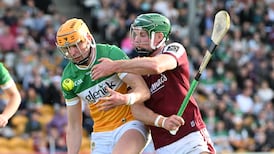"Fore!" Padraig Harrington's first action from the bunker in the short game practice area at Oakmont Country Club yesterday was to blade a shot over the green, narrowly missing the lone figure standing ankle deep in rough on the far side who had been practising a rescue shot that likely will be commonplace in this 107th US Open. His second action was to yell out a warning, and then to raise his hand in apology.
Welcome to Oakmont. Welcome to what could be the toughest major championship.
For Harrington, who missed the cut in the St Jude Championship in Memphis, the positive of that failure was that it enabled him to get to Pittsburgh earlier than scheduled. On Sunday, he played all 18 holes; it was his first view of Oakmont. His verdict? "I don't think I've ever seen a course with as much trouble off the fairways . . . normally you might have a bunker or water on one side and rough on the other, but this has two sides of the fairway (with trouble)," he said.
And, yet, as Harrington - who has been grouped with US Masters champion Zach Johnson and South Africa's Ernie Els, the last player to win a US Open at Oakmont - conceded, it will be the greens that make or break a player this week.
As a youngster, when he first started playing the game, Harrington was terrified by the severity of the greens on his home course at Stackstown, where "there were eight or nine greens you couldn't stop the ball if you were past the hole". The greens at Oakmont have brought back those memories.
"It's been a long time since I've seen greens of such severity. They're very severe. They're struggling to find pin positions and the greens are due to get even firmer. To be honest, they don't need to do any of that to get level par as the winning score. This course has got everything to make it tough. It is tough with the hazards off the tee. It is tough with the rough off the tee. It is tough with the rough around the greens. It is tough with the pin positions.
"It is tough with the slope on the greens. It is tough with the pace of the greens. You know, it makes Winged Foot (last year) look benign," claimed Harrington.
Indeed, Harrington used the analogy of the "wall of death" to describe some of the shots that players are likely to have to attempt during the championship should they miss the greens with approach shots. He explained: "You will see a lot of Wall of Death shots. That means that, if you are on the wrong side of the Wall of Death, you will see guys chipping 40 feet past the pin to run it back to the hole. That will happen a lot, guys chipping from awkward spots will have to chip away from the pin and get it to run backwards."
Harrington, who finished fifth in last year's championship by completing his final round with three successive bogeys to eventually lie two strokes behind winner Geoff Ogilvy, is one of two Irish players in the field. Graeme McDowell, who warmed-up with a top-10 finish in the Austrian Open, booked his place via the International Qualifying in Walton Heath last week. The Ulsterman flew in yesterday, but only plans on playing a full 18 once and nine holes in preparation.
While he missed the cut in the St Jude, the upshot for Harrington is that he has more time to prepare.
Although he played a further nine holes yesterday, the vast majority of his time was spent around the short game practice, mainly chipping and putting. He has ditched the Torpedo-shafted putter he used since the Players, including his victory in the Irish Open, in favour of the traditional Odyssey two-ball putter that he used for the early part of the season.
Prior to getting to Oakmont, Harrington had heard that many players wouldn't even bother trying to get approach shots onto the green and, instead, would intentionally play over the back. But that option isn't really viable. "They used to say that, but now there is four inches of rough off the greens. Do you want to play a pitch and run from 60 feet out of four inches of rough? It is not an easy task. And I don't think at this level we can afford to miss a green at all."
With the greens running at speeds of more than 13 on the stimpmeter, and faster on many surfaces due to the difficulty in actually finding level areas, Harrington is expecting a severe test.
"It will be difficult. I'd certainly take four 72s now and I don't know of any other tournament where I'd take eight-over-par starting off. It must be the toughest (test).
"But I'm looking forward to it. I've a few days to get things right and I'm glad I've done a lot of work (already). If I go into it in good form, I'll certainly be looking forward to the challenge."









